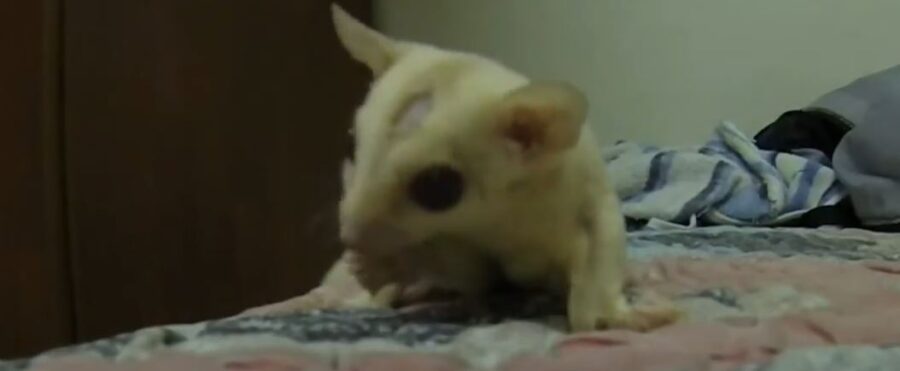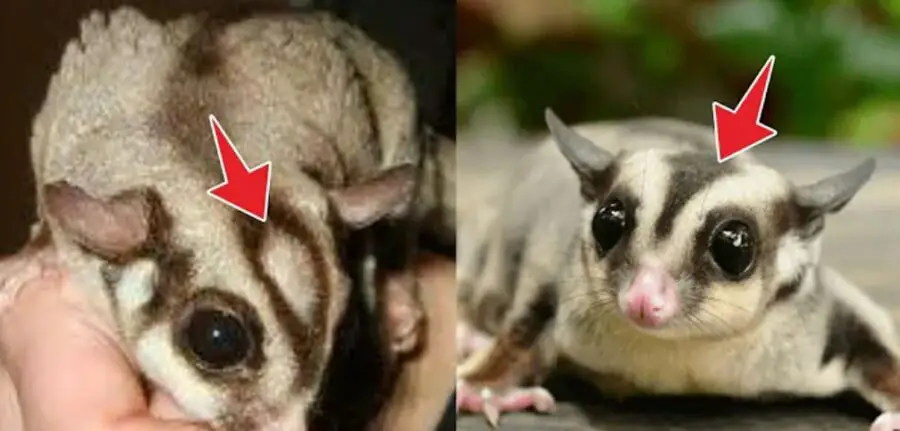Harry, our male sugar glider, was getting too excited and using his head too often to interact with his world around him. But, why does my sugar glider have a bald spot?
His hyperactivity reduced after he was neutered. Slowly but surely, the bald spot was gone and hair grew back in that area.
In this article, we should explain the situation going on to cause bald spots and baldness in sugar gliders.
Why Does My Sugar Glider Have a Bald Spot?
The ball spot you are noticing is common with male sugar gliders. He is reaching sexual maturity which is about 12 to 15 months of age.
If the bald spot is the only area where he has lost hair, it should be a patch right above the forehead and nowhere else. This is where one of their scent glands are located.
If you notice patchiness or loss of hair in other areas it could be due to changes in weather conditions, poor diet, illness or stress.

Reason For Sugar Sugar Glider Bald Spot
This happened to us when we had a male sugar glider that was not neutered. The bald spot on his forehead was greasy at first. We started to notice it at around 8 to 9 months of age.
It was alarming to us, but we found that it was completely normal because this is where one of his 3 scent glands are located. The other two scent glands are located at the center of his chest and another around his genital area.
They use the bald spot to rub different areas to mark:
- their mate
- offspring
- territory
Why Does A Sugar Glider Bald Spot Smell?
Some people have said that their sugar glider’s bald spot smells foul. We recommend making sure that his diet has a balance of pelleted food, fruits and vegetables. It will help make the smell less noticeable.
If your male sugar glider is neutered, you will notice the urge for them to mark with their scent glands reduced.
You may also find that the foul odor you have smelled in the past has now been lessened. Finally, with neutering, the bald spot will fill back in with fur.
Sugar Glider Hair Loss Explained
Male sugar gliders have bald spots on the top of their head shaped like a diamond if they are not neutered. This is an area that they use to rub against surfaces to mark their territory, their mate or their offspring.
If they are neutered, the bald spot will fill in. There are other balding areas where sugar gliders experience hair loss and it could be more of a concern to you. Let’s take a look.
Other Reasons For Sugar Glider Baldness
1. Anxiety
Both males and females can experience anxiety and this spikes their adrenal glands, In turn, this creates a loss of fur in areas of their body that makes them look a little patchy.
2. Mites
If your sugar glider has ever had a bout of mites, it can lead to patchiness and missing hair. They could be pulling the hair themselves and it can also lead to self-mutilation if not treated. External parasites are an issue when dealing with sugar gliders and we must be aware of this.
3. Grooming
Marsupials love to groom themselves. Sometimes they may do it too often or not enough. If a sugar glider is not grooming enough the hair can clump together.
The hair can become thinner and eventually fall. Excessive grooming can also lead to hair loss as well. Usually this is an emotional issue dealing with stress.
Is your sugar glider shaking during this time? Find out how to prevent this.

Do Female Sugar Gliders Have Bald Spots?
Female sugar gliders have scent glands in their genital area and in their pouch, but they do not have one on the top of their head. This is why females do not have a diamond shaped bald spot in this location.
Our female sugar glider experienced some anxiety when we first brought her home. She was over-grooming and pulling away at clumps of hair on her body.
At first we thought they were mites or any other type of external parasite. We soon figured out that if we gave her more chew toys, a warm pouch elevated at the top of her spacious cage, she settled in and her hair started to grow back.
Is My Sugar Glider Going Bald Because of a Bad Diet?
Baldness isn’t necessarily associated with a poor diet in sugar gliders. However, make sure that your sugar glider is getting plenty of protein rich foods, occasional insect treats, lots of water, fruits and vegetables.
Sometimes when sugar gliders have a nutritional deficit, you could notice hair loss. Another issue is with sugar gliders being up too much during the day.
You have to keep in mind that they are nocturnal marsupials that need rest throughout the day. A sleep-deprived sugar glider may also develop hair loss. This may also lead to other types of emotional stress and negative behavioral traits.

Difference Between Male and Female Sugar Glider Fur
- A male sugar glider has a bald spot on the top of his head shaped like a diamond. This is because it is a scent gland and it could be slightly discolored or greasy as well.
- It may not be completely bald, but it helps the male to mark his territory, offspring and mate. A female has a scent gland in her genital area and in her pouch.
- Male and female sugar gliders can both have grey fur with a creamy color chest and stomach.
- They may both have a black stripe that runs down the length of their back.
- Both males and females have hairless ears.
- Males also have a small furry scrotum if you inspect that area closely.
Conclusion
Your male sugar glider is not experiencing male pattern baldness. This is more of a natural tendency for males that reach sexual maturity.
They use scent glands located at the top of their head to rub against multiple surfaces. The area could have a musky odor as well. This bald spot can grow back if your male sugar glider is neutered.
Thank you for visiting PocketPetCentral.com for the best information to help you enjoy the life of your pocket pet companion in a fun, safe & healthy way.


